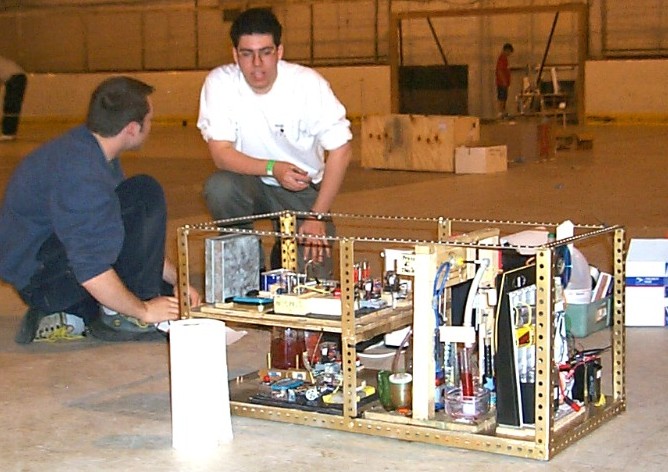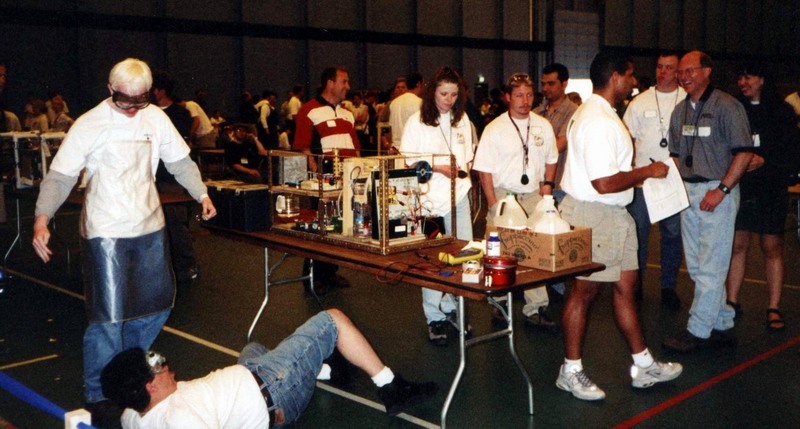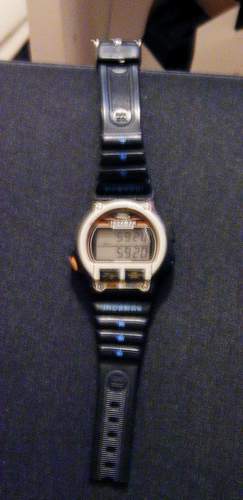Mission Impossible
This is a picture of me explaining the workings of the Mission Possible device, seen as the golden machine, to a judge at the 2000 State competition at Michigan State University. This is the same mission that went on to gold medal at nationals in Spokane, Washington. I am so very proud of this device, which met an unfortunate demise in the trip home via Yellowline Freight.
Rules of Mission Possible
Mission Possible is an engineering event in Science Olypiad. Prior to competition, the M.P. device is built and tested according to the rules. The M.P. device is competed before a panel of judges by three team members. The M.P. device must accomplish a task within a prescribed time using a set of energy transfers. For the 2000 competition, this task was to launch a small (8-10cm) foam ball out the top of the device 60 seconds after a quarter is dropped into the top. The device operate by "energy transfers" where one form of energy is transformed or triggers another. The forms are electrical, mechanical, thermal, chemical, and electromagnetic (light & radio). For nationals, bonus points were given for ringing a bell 10 seconds prior to launching the ball. The M.P. device must fit inside a 50cmX50cmX100cm box. No hazardous materials are allowed, no voltages over 13v between can exist between any two points and there is no contact allowed except to drop the quarter in. Bonus points are given for a certain subset of energy transfers. A maximum of 6 transfers of beginning with any certain energy are counted for a total of 30 tallied energy transfers. All transfers must operate serially, one after the one before. If the device runs perfectly with all bonuses and transfers, the max score is 622 points. There is no requirement for originality (meaning not repeating the same thing 6 times) but it is the tie-breaker.
The Gold Champion
My senior year was the third time I had competed the Mission Possible event. At this time I had a lot of experience in troubleshooting and design analysis. I also had built a great support team. Stefan Kilyanek and Dave Groulx were instrumental in the success of the device. Stefan and Dave are both chemistry wizards and also helped me to see flaws and issues before they became problems. Our device consisted of a modular design using sliding and plug in modules and hard wired power and signal buses built onto a welded steel frame. This allowed us to troubleshoot, test, and set up modules individually without affecting the whole. All electronics and mechanical systems were designed and built by me. The chemistry and thermal processes were drafted by Stefan and Dave and sent to me for construction.
The previous link was for the complete flowchart for our mission possible device. I will make an interesting point that is not apparent from the flowchart. At the end there are a few transfers that appear to do nothing but take time. This is exactly the point as the first 29 counted transfers and all in between occur in under 8 seconds. The timer and screw count off the remaining time with precision. In this way, a 50% variation in run time accounts for only a total of +/- 4 seconds, instead of 30. At nationals, our time was 59.2 seconds, with a perfect run, no stops or touches or penalties. We scored a perfect 622. As you can see from the next picture, I kind of fell over with excitement with Stefan standing over me on the left after we completed the run. You would too if you knew that you had taken a step beyond all your competition.
First Place at Nationals
One of the best days of my life was that day. This is a picture of (left to right) Dave Groulx, me, and Stefan Kilyanek standing with our gold on. What was in my left hand was a $1000 scholarship from Lockheed Martin, which I must thank L.M. for becoming involved with Science Olympiad.



